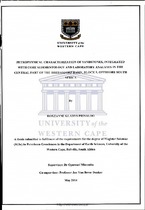| dc.description.abstract | The area of concentration of this particular project is focused on the central part of the Bredasdorp Basin, block 9, offshore South Africa. Petrophysical evaluation of sandstone reservoirs of the F-0 tract offshore South Africa has been performed. The main aim of this study is to investigate the reservoir potential of this tract, using processed data of four wells which include; F-01, F-02, F-R1 and F-Sl. The data used for this evaluation include; wireline logs, conventional core data and special core analysis data (SCAL). Combining these laboratory results with wireline log examinations and core descriptions gives an idea of the sedimentary environment, sandstone properties and ultimately generates an effective model. Six facies were identified from the core, based on the grain size (facies 1, 2, 3, 4, 5 and 6). Facies 1 and 2 had the best reservoir rock qualities, whereas facies 3 to 6 are classified as poor or non - reservoir rock. These reservoirs are deposited in a shallow marine environment. Porosity and permeability are the two main properties which ultimately determine the quality of the reservoir. These two property measurements were taken from the routine core analysis and SCAL data and generated for the entire well using various methods. The Steiber equation was used to calculate the volume of clay from the gamma ray log. The average porosity for all four wells range between 0.5% to 17%. The minimum value recorded for permeability is 0.009mD and the maximum value is 235mD, even though permeability seems to have a broad range, the majority of the values recorded is less than lOmD. Based on these values, the reservoir rock properties are generally classified as moderate to fair. In some places, where the permeability is more than 100mD, the reservoir is classified as very good. Capillary pressure and conventional core data was compared to the log calculated water saturation models. The best fit model was the Indonesia model. The average water saturations range from 10% to 88 %. A total of eleven reservoir intervals were identified from the four wells based on the cut - off parameters. For an interval to be classified as a reservoir interval, the porosity should be equal or greater than 6%, water saturation equal or less than 35% and the volume of clay should be equal to or less than 40%. From the eleven intervals identified, four intervals contain gas and the remainder of the intervals identified are water bearing. The gross thickness of the reservoir ranges from 10m to 66m and net pay interval from 0.46m to 51.6m. | en_US |

